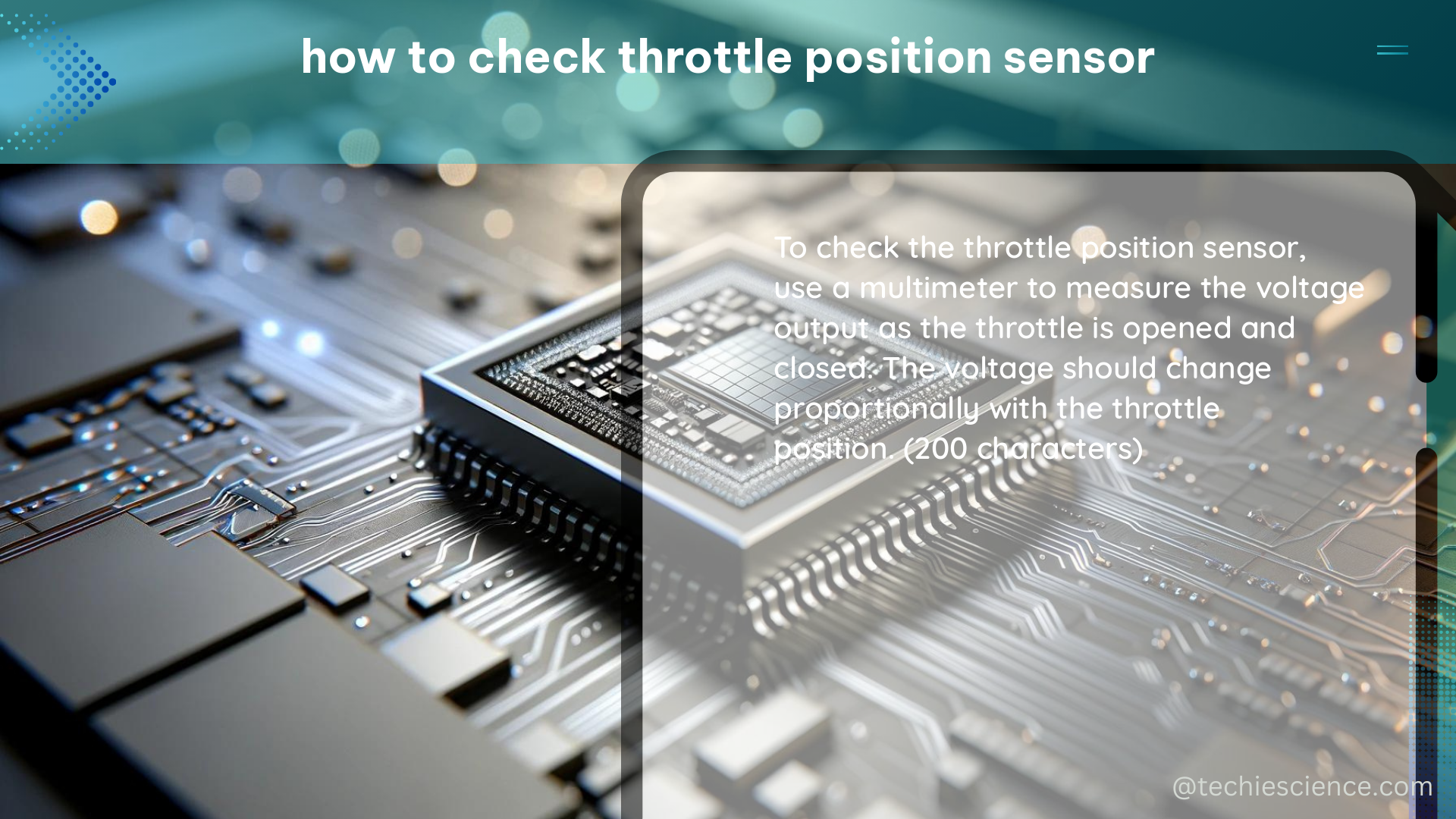The throttle position sensor (TPS) is a critical component in modern vehicles, responsible for providing the engine control unit (ECU) with real-time information about the position of the throttle plate. This data is essential for accurate fuel metering, ignition timing, and overall engine management. Properly checking and diagnosing the TPS is crucial for maintaining optimal engine performance and fuel efficiency. In this comprehensive guide, we’ll delve into the step-by-step process of checking a throttle position sensor, covering the necessary tools, testing procedures, and technical specifications to ensure your vehicle’s TPS is functioning correctly.
Locating the Throttle Position Sensor
The first step in checking the TPS is to locate it on your vehicle. The TPS is typically mounted on the throttle body, which is the component that houses the throttle plate. It is usually accessible and easy to identify, as it will have three wires connected to it: power, ground, and signal.
Gathering the Necessary Tools

To check the TPS, you’ll need the following tools:
- Digital Multimeter: A high-quality digital multimeter is essential for measuring the resistance and voltage of the TPS. Look for a multimeter with a minimum of 10 megohms of input impedance to ensure accurate readings.
- Vehicle Service Manual: Refer to your vehicle’s service manual for the specific TPS specifications and testing procedures. This information is crucial for interpreting the readings you obtain with the multimeter.
Measuring TPS Resistance
- Disconnect the TPS Connector: Locate the TPS connector and carefully disconnect it, ensuring you don’t damage the wiring.
- Set the Multimeter: Set your multimeter to the ohms (Ω) setting.
- Measure Resistance: Touch the multimeter probes to the power and signal wires of the TPS. With the throttle closed, the resistance should be in the range of 100-200 ohms.
- Observe Resistance Changes: Slowly open the throttle and observe the resistance reading on the multimeter. The resistance should increase as the throttle opens, reaching a range of 2000-3000 ohms with the throttle fully open.
Checking TPS Voltage
- Reconnect the TPS Connector: Carefully reconnect the TPS connector, ensuring a secure connection.
- Set the Multimeter: Switch your multimeter to the DC voltage (V) setting.
- Measure Voltage: Touch the positive multimeter probe to the signal wire and the negative probe to the ground wire of the TPS.
- Observe Voltage Changes: With the engine off, the voltage should be around 0.5 volts. Start the engine and slowly open the throttle. The voltage should increase smoothly, reaching approximately 4.5 volts with the throttle fully open.
Interpreting TPS Specifications
The specific TPS specifications can vary depending on the make, model, and year of your vehicle. Refer to your vehicle’s service manual to find the following technical details:
| Specification | Typical Range |
|---|---|
| Resistance Range | 100-200 ohms (closed throttle) 2000-3000 ohms (fully open throttle) |
| Voltage Range | 0.5 volts (closed throttle) 4.5 volts (fully open throttle) |
| Response Time | ≤ 50 milliseconds |
| Temperature Range | -40°C to +125°C |
Compare the readings you obtained with the multimeter to the specifications in your service manual. If the TPS is not within the expected range or does not respond as expected, it may indicate a problem with the sensor and require further diagnosis or replacement.
Troubleshooting Common TPS Issues
If the TPS is not functioning within the expected parameters, consider the following potential issues:
- Wiring Harness Damage: Check the TPS wiring harness for any signs of damage, such as fraying, cuts, or loose connections.
- Sensor Failure: If the TPS resistance and voltage readings are not within the specified ranges, the sensor itself may be faulty and require replacement.
- Throttle Body Contamination: Dirt, debris, or carbon buildup on the throttle body can affect the TPS readings. Clean the throttle body according to the manufacturer’s recommendations.
- ECU Programming: In some cases, the ECU programming may need to be updated or recalibrated to properly interpret the TPS signals.
Conclusion
Properly checking the throttle position sensor is a crucial step in maintaining the overall health and performance of your vehicle’s engine. By following the step-by-step process outlined in this guide, you can accurately diagnose any issues with the TPS and take the necessary actions to ensure your vehicle is running at its best. Remember to always refer to your vehicle’s service manual for the specific TPS specifications and testing procedures, as they may vary between makes and models.
References
- Emerson Control Valve Handbook: https://www.emerson.com/documents/automation/control-valve-handbook-en-3661206.pdf
- HELLA Technical Information: https://www.hella.com/techworld/us/Technical/Sensors-and-actuators/Check-change-ABS-sensor-4074/
- Vehicle Service Manual: Consult your vehicle’s service manual for specific TPS specifications and testing procedures.

The lambdageeks.com Core SME Team is a group of experienced subject matter experts from diverse scientific and technical fields including Physics, Chemistry, Technology,Electronics & Electrical Engineering, Automotive, Mechanical Engineering. Our team collaborates to create high-quality, well-researched articles on a wide range of science and technology topics for the lambdageeks.com website.
All Our Senior SME are having more than 7 Years of experience in the respective fields . They are either Working Industry Professionals or assocaited With different Universities. Refer Our Authors Page to get to know About our Core SMEs.